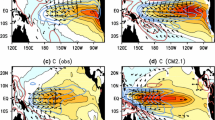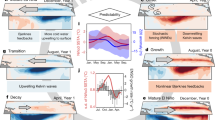Abstract
Estimates of changes in the frequency of transitions between different phases of El Niño processes over the past seven decades (1950–2019) have been obtained. Positive (El Niño phase) and negative (La Niña phase) surface temperature anomalies in the equatorial latitudes of the Pacific Ocean are associated with the strongest interannual variations in global surface air temperature. Significant differences in trends have been revealed for different types of El Niño and La Niña phenomena, characterized by surface temperature anomalies in the equatorial latitudes of the eastern (Niño3) and central (Niño4) regions of the Pacific Ocean. The tendencies of an increase in the frequency of occurrence of El Niño phases using the Niño4 index and neutral phases using the Niño3 index are noted. At the same time, for both types of El Niño, there is a tendency towards a decrease in the frequency of occurrence of La Niña phases. A significant contribution to the noted trends is associated with the regimes of a long (at least one year) manifestation of the corresponding phases.


Similar content being viewed by others
REFERENCES
Climate Change 2013: The Physical Science Basis. Contribution of Working Group I to the Fifth Assessment Report of the Intergovernmental Panel on Climate Change, Ed. by T. F. Stocker, D. Qin, G.-K. Plattner, (Cambridge Univ. Press, Cambridge, 2013)
J. Bjerknes, “A possible response of the atmospheric Hadley circulation to equatorial anomalies of ocean temperature,” Tellus 18, 820–829 (1966).
J. Bjerknes, “Atmospheric teleconnections from the equatorial Pacific,” Mon. Weather Rev. 97, 163–172 (1969).
K. E. Trenberth, “The definition of El Niño,” Bull. Am. Meteorol. Soc. 78, 2771–2777 (1997).
J. D. Neelin, D. S. Battisti, A. C. Hirst, F.-F. Jin, Y. Wakata, T. Yamagata, S. E. Zebiak, “ENSO theory,” J. Geophys. Res. 103, 14261–14290 (1998).
K. Arpe, L. Bengtsson, G. S. Golitsyn, et al., “Analysis and modeling of the hydrological regime variations in the Caspian Sea basin,” Dokl. Earth Sci. 366 (4), 552–556 (1999).
G. V. Gruza, E. Ya. Ran’kova, L. K. Kleshchenko, and L. N. Aristova, “Relating climate anomaly in Russia with ENSO,” Meteorol. Gidrol., No. 5, 32–51 (1999).
I. I. Mokhov, A. V. Eliseev, and D. V. Khvorost’yanov, “Evolution of the characteristics of interannual climate variability associated with the El Niño and La Niña phenomena,” Izv., Atmos. Ocean. 36 (6), 681–690 (2000).
M. Latif, K. Sperber, J. Arblaster, P. Braconnot, D. Chen, A. Colman, U. Cubasch, C. Cooper, P. Deleeluse, D. DeWitt, L. Fairhead, G. Flato, T. Hogan, M. Ji, M. Kimoto, et al., “ENSIP: the El Niño simulation intercomparison project,” Clim. Dyn. 18, 255–276 (2001).
M. A. Petrosyants and D. Yu. Gushchina, “On the definition of the El Niño and La Niña phenomena,” Meteorol. Gidrol., No. 8, 24–35 (2002).
I. I. Mokhov, D. V. Khvorostyanov, and A. V. Eliseev, “Decadal and longer term changes in El Niño–Southern Oscillation characteristics,” Int. J. Climatol. 24, 401–414 (2004).
N. K. Larkin and D. E. Harrison, “On the definition of El Niño and associated seasonal average U.S. weather anomalies,” Geophys. Res. Lett. 32, L13705 (2005).
M. J. McPhaden, S. E. Zebiak, and M. H. Glantz, “ENSO as an integrating concept in earth science,” Science 314, 1740–1745 (2006).
I. I. Mokhov and D. A. Smirnov, “Study of the mutual influence of the El Niño–Southern Oscillation processes and the North Atlantic and Arctic oscillations,” 42 (5), 598–614 (2006).
S. Bronnimann, “Impact of El Nino–Southern Oscillation on European climate,” Rev. Geophys. 45, RG3003 (2007).
K. Ashok and T. Yamagata, “The El Niño with a difference,” Nature 461, 481–484 (2009).
J. S. Kug, F. F. Jin, and S. I. An, “Two Types of El Niño events: Cold tongue El Niño and warm pool El Niño,” J. Clim. 22, 1499–1515 (2009).
S.-W. Yeh, J.-S. Kug, B. Dewitte, et al., “El Niño in a changing climate,” Nature 461, 511–514 (2009).
M. Collins, S.-I. An, W. Cai, et al., “The impact of global warming on the tropical Pacific Ocean and El Niño,” Nat. Geosci. 3, 391–397 (2010).
I. I. Mokhov, “Specific features of the 2010 summer heat formation in the European territory of Russia in the context of general climate changes and climate anomalies,” Izv., Atmos. Ocean. 47 (6), 653–660 (2011).
K. Takahashi, A. Montecinos, K. Goubanova, and B. Dewitte, “ENSO regimes: Reinterpreting the canonical and Modoki El Niño,” Geophys. Res. Lett. 38, L10704 (2011).
Y.-G. Ham and J.-S. Kug, “How well do current climate models simulate two types of El Niño?,” Clim. Dyn. 39, 383–398 (2012).
M. Watanabe, J.-S. Kug, F.-F. Jin, et al., “Uncertainty in the ENSO amplitude change from the past to the future,” Geophys. Res. Lett. 39, L20703 (2012).
H. Bellenger, E. Guilyardi, J. Leloup, M. Lengaigne, and J. Vialard, “ENSO representation in climate models: From CMIP3 to CMIP5,” Clim. Dyn 42, 1999–2018 (2014).
S. T. Kim, W. Cai, F. F. Jin, A. Santoso, L. Wu, E. Guilyardi, and S.-I. An, “Response of El Niño sea surface temperature variability to greenhouse warming,” Nat. Clim. Change 4, 786–790 (2014).
I. V. Zheleznova and D. Yu. Gushchina, “The response of global Atmospheric circulation to two types of El Nino,” Russ. Meteorol. Hydrol. 40 (3),170–179 (2015).
I. I. Mokhov and A. V. Timazhev, “Assessment of the predictability of climate anomalies in connection with El Niño phenomena,” Dokl. Earth Sci. 464 (6), 1089–1093.
M. Latif, V. A. Semenov, and P. Wonsun, “Super El Niños in response to global warming in a climate model,” Clim. Change 132, 489–500 (2015).
I. I. Mokhov and V. A. Semenov, “Weather and climate anomalies in Russian regions related to global climate change, " Russ. Meteorol. Hydrol. 41 (2), 84–92 (2016).
I. I. Mokhov and D. S. Smirnov, “Relation between the variations in the global surface temperature, El Niño/La Niña phenomena, and the Atlantic multidecadal oscillation,” Dokl. Earth Sci., 467 (2), 384–388 (2016).
I. I. Mokhov and A. V. Timazhev, “Assessing the probability of El Niño-related weather and climate anomalies in Russian regions,” Russ. Meteorol. Hydrol. 42 (10), 635–643 (2017).
W. Cai, G. Wang, B. Dewitte, et al., “Increased variability of eastern Pacific El Niño under greenhouse warming,” Nature 564, 201–206 (2018).
I. I. Mokhov and A. V. Timazhev, “Phase transitions for different El Niño types and periods,” in Research Activities in Atmospheric and Oceanic Modelling, Ed. by E. Astakhova (2019), WCRP Rep. No. 12/2019, pp. 07–08.
H.-L. Ren, J. Zuo, and Y. Deng, “Statistical predictability of Niño indices for two types of ENSO,” Clim. Dyn. 52, 5361–5382 (2019).
B. Wang, X. Xiao Luo, Y.-M. Yang, W. Sun, M. A. Cane, W. Cai, S.-W. Yeh, and J. Liu, “Historical change of El Niño properties sheds light on future changes of extreme El Niño,” Proc. Natl. Acad. Sci. USA 116, 22512–22517 (2019).
Y. Wang, Y. Luo, J. Lu, and F. Liu, “Changes in ENSO amplitude under climate warming and cooling,” Clim. Dyn. 52, 1871–1882 (2019).
Z. Zhang, B. Ren, and J. Zheng, “A unified complex index to characterize two types of ENSO simultaneously,” Sci. Rep. 9, 8373 (2019). https://doi.org/10.1038/s41598-019-44617-1
O. V. Marchukova, A. S. Lubkov, and E. N. Voskresenskaya, “The quality of the reproduction of El Niño and La Niña events using different reconstructed sea surface temperature data sets,” Vestn. S.-Peterb. Univ., Nauki Zemle 65 (1), 96–120 (2020).
I. I. Mokhov, “Anomalous winters in regions of northern Eurasia in different phases of the El Niño phenomena,” Dokl. Earth Sci. 493 (2), 649–653 (2020).
I. I. Mokhov, A. V. Chernokulsky, and A. M. Osipov, “Atmospheric centers of action in the Northern and Southern Hemispheres: Features and variability,” Russ. Meteorol. Hydrol. 45 (11), 749–761 (2020).
A. Carreric, B. Dewitte, W. Cai, et al., “Change in strong Eastern Pacific El Niño events dynamics in the warming climate,” Clim. Dyn. 54, 901–918 (2020).
G. Beobide-Arsuaga, T. Bayr, A. Reintges, and M. Latif, “Uncertainty of ENSO-amplitude projections in CMIP5 and CMIP6 models,” Clim. Dyn. 56, 3875–3888 (2021).
Funding
This work was supported by the Russian Science Foundation, project 19-17-00240. The features of recent years were analyzed within the framework of a project and were supported by the Ministry of Education and Science of Russia, agreement no. 075-15-2020-776.
Author information
Authors and Affiliations
Corresponding author
Rights and permissions
About this article
Cite this article
Mokhov, I.I. Changes in the Frequency of Phase Transitions of Different Types of El NIño Phenomena in Recent Decades. Izv. Atmos. Ocean. Phys. 58, 1–6 (2022). https://doi.org/10.1134/S000143382201008X
Received:
Revised:
Accepted:
Published:
Issue Date:
DOI: https://doi.org/10.1134/S000143382201008X




